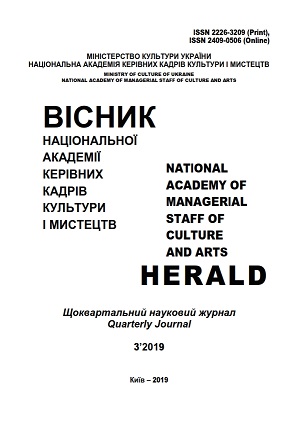Символіка Монсальвату і Валгалли у музичній драматургії оперного міфу Р. Вагнера «Лоенгрін»
Symbolism of Monsalvat and Valhalla in the Musical Drama of the Opera Myth by R. Wagner “Lohengrin”
Author(s): Olena Georhiyivna RoshchenkoSubject(s): Theatre, Dance, Performing Arts, Cultural history, Music, Semiology, History of Art
Published by: Національна академія керівних кадрів культури і мистецтв
Keywords: mythology opera studies; author‘s transmythology; a new myth; chronotop-sacra; mythologized onomastics; toponymy; mythology of the Magic Mountain; miracle; magic;
Summary/Abstract: The aim of the article is to specify the symbolism of Monsalvat and Valhalla in the chronotop-sacra of the opera myth by R. Wagner ―Lohengrin‖. Research methodology is based on the principles of the mythology opera studies, music onomatology (the study of the mythologized toponymy); intromythological, encyclopaedic (the consideration of a ―new myth‖ as a romantic docta stilo), functional and typological, mythological and symbolic types of analysis. Scientific novelty. An attempt is made at revealing the characteristic aspects of functioning of the mythologized oronyms in the chronotop-sacra. Instead of the mythologized oronym Valhalla in Ortrud‘s ―prayer‖, the proper names of the former rulers of the German-Scandinavian world are introduced, which contain a hidden plot of the sacred mountain of the old world. Valhalla and Monsalvat had similar functions in different historical epochs (the world mountain of resurrection, a castle with a sacred hall, a lodging of celestial warriors of light), providing them the meaning of semantic twins. Christianization has caused the displacement of pagan mythology outside the sacral chronotop: in one mythological picture of the world there is no place for two sacred objects whose functions coincide. Valhalla, having taken an underground locus, turns into the rival of Monsalvat. The opera transmythology of ―Lohengrin‖ is based on the unification of mythologized stories of Valhalla and Monsalvat in the plot unity. Their confrontation is considered as the battle of Wunder and Zauber, an important role in the development of which has a mythologeme-image of the enchanted knight. The introduction of the name of Parsifal contributes to the addition of plot analogies with Klingsor – the castle-mountain, the embodiment of Zauber, another rival of Monsalvat from the last Wagner‘s opera. The time of the development of the action of ―Lohengrin‖ is considered as the day of the destroyed Klingsor. Conclusions. The theme of the confrontation between light and darkness often translates into the mythologeme ―magic mountain‖ through the composer‘s usage. The symbolism of Monsalvat and Valhalla in the musical drama is identified through the usage of mythology opera studies as an art based on the synthesis of the basic principles of mythology and opera studies, the application of the fundamentals of musical onomatology, common in both areas of mythologized onomastics: anthropo- and toponymy. Through the symbolism of the explicit (Monsalvat) and implicit oronyms (Valhalla and its analogues – Venus the mountain, Klingsor) in the mythologized toponymy operaasmyth there is an elucidation of the insight of confrontation between light and darkness, Christianity and paganism. The drama of the opera is interpreted as a duel of Monsalvat and Valhalla for dominating over the Brabant (Midgard) and Asgard.
Journal: Вісник Національної академії керівних кадрів культури і мистецтв
- Issue Year: 2019
- Issue No: 3
- Page Range: 166-171
- Page Count: 6
- Language: Ukrainian

